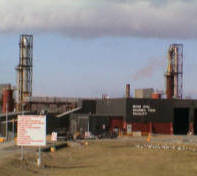Incinerators - Unsafe At Any Speed   See local news items on incineration posted April 22 and May 6 of 2003. According to Joint Action Group's Technology Factbook incineration is a process in which "extreme heat, supplemented with oxygen, destroys most contaminants in soil, sediment, sludge, or liquids". An incinerator is further defined as "a type of furnace that burns contaminated material at a controlled temperature high enough (870 to 1200oC) to destroy the harmful chemicals it contains". The material is placed in the incinerator where it is heated. To increase the amount of harmful chemicals destroyed, workers control the amount of heat and air in the incinerator. As the chemicals heat up, they change into gases, which pass through a flame to be heated further. The heat breaks them down into smaller components that combine with oxygen to form gases and steam. The gases produced in the incinerator pass through air pollution control equipment to remove metals, acids, and particles of ash. These wastes must go to an approved disposal site. The other combustion gases, like steam and carbon dioxide, are released through a stack. The soil or ash remaining in the incinerator after burning may go to a landfill or an approved facility, depending on the quantity of contaminants that remain. The amount of material requiring such disposal is much less than the original amount of material that was burned. There is a massive weight of evidence to show that incinerators are damaging people's health. Those within the "fallout zone" (up to 7.5 Km around an incinerator) are most affected. However, the effects are even more far reaching. After incineration, the solid waste consisting of heavy-metals-contaminated ash is dumped on special landfill sites. Municipal waste incinerators produce high levels of dioxins, which are the most toxic chemicals known to the human race. Many heavy metals and very fine particles may lodge in the lungs and can't be removed by the body's defence mechanisms. The dioxins emitted by incinerators have been shown to lead to infertility, birth defects, cancers, heart disease and respiratory problems. Nova Scotia had only one active incinerator (shown above on the left) located in Sydney. This plant disposed of domestic waste as well as toxic medical waste for the entire province. Although this incinerator is now closed, it sits as a reminder of what can happen when aa investment is made in questionable technology - Despite repeated failure of its emissions tests, CBRM continued to operate this incinerator, and the province continued to ship medical waste to this toxic polluter. CBRM residents are not likely to again allow another incinerator to pollute their communities. The toxic waste incinerator shown above (on the right) is located on SYSCO (Steel Plant) property near the SYSCO "power plant"(now demolished) and was within range of of the new Whitney Pier elementary school. Although it has not yet been dismantled, there are no plans by STPA to reactivate this Fluidized-bed incinerator. In JAG's "Community Recommendation Report" it is noted that "On-site incineration has the least community support of the destruction technologies". For more information on the dangers of incineration check out: |
